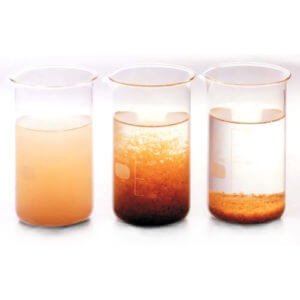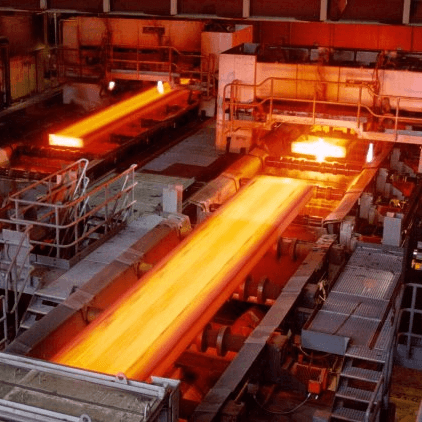

Coagulant
The separation of fine particles and colloids takes a long time, so they use chemical coagulants to increase particles and reduce settling time. When the coagulant is added to the water, some of it is used to modulate the electrical potential of the particles, and some amount is combined with the water’s alkalinity. For example, when adding alum to water, aluminum hydroxide is produced, which, while depositing, removes the suspended particles of the environment.
Al2(SO4)3 + 6H2O→2Al(OH)3↓ + 3H2SO4
The acid produced in the above reaction reacts with water alkalinity and produces carbon dioxide. This gas interferes with the process of coagulation and causes it to float, thereby controlling the pH to prevent the production of CO2 and to perform better the coagulation process. The coagulant used can be divided into two categories:
Cations such as iron and aluminum ions that absorb the particle surface.
Organic soluble organic substances that produce cation in solution, most of which are polymer materials.
Characteristics of Coagulants
Coagulants must have the following characteristics:
Power of coagulation.
Do not cause water poisoning.
to be economical.
One of the benefits of mineral coagulants is helping to absorb phosphates effectively. Phosphates are biologically biologically resistant and resistant to biological interactions.
Most coagulants contain iron and aluminum compounds and, due to their acidity, reduce the pH of the water. The pH of the water affects the surface charge of the particles and the clogging of the clots, it is necessary to adjust the pH of the water with the help of materials such as lime or gum.
The use of metal salts based on the neutralization of the colloidal charge due to the high amount of sludge produced by the use of coagulants from coagulant materials with regard to economic issues and operating efficiency, and because of the importance of the subject, a number of Mineral coagulants are described below.
A few examples of mineral coagulants
A) Aluminum sulfate or Alum white (Al2 (SO4) 3.18H2O)
It is also known as AUM and is used more than other materials. It has an optimal performance in the pH range of 5.5 to 7.5. Aluminum sulfate produces aluminum hydroxide with alkali in the water, which itself is the core of particle accumulation and produces more coarse particles. In the case of low alkalinity, water is usually used from lime or sodium carbonate. It is necessary to do this before adding alum to the water. The reactions that cause alum with lime or sodium carbonates or alkali substances are as follows:
Reaction with lime:
Al 2 (SO 4) 3 + 3Ca (OH) 2 → 2Al (OH) 2 + 3CaSO4
Reaction with sodium carbonate:
Al2 (SO4) 3 + 3Na2CO3 + 3H2O → 2Al (OH) 3 + 3Na2SO4 + 3CO2
Reaction with calcium bicarbonate:
Al2 (SO4) 3 + 3Ca (HCO3) 2 → 2Al (OH) 3 + 3CaSO4 + 6CO2
The use of alum increases the hardness of water and produces carbon dioxide which is corrosive. Meanwhile, if sodium and potassium salts are high in water, colloidal substances form as fine deposits.
According to studies conducted in recent years, aluminum can be effective in causing Alzheimer’s disease, which causes people to become oblivious. For this reason, in some articles, the use of aluminum compounds in water treatment has been declared dangerous in recent years. But this issue is not mentioned in drinking water standards.
For the effectiveness of the alum performance and pH adjustment, the added amounts of alum and alkaline materials should be appropriate. Typically, each ml of 0.5 mg sodium carbonate, 0.7 mg of lime and 0.54 mg of calcium carbonate per liter of water is appropriate.
B) sodium aluminate (Na2Al2O4)
This material is an oxidizing aluminum which has been stabilized by the caustic soda, and its industrial composition contains several percent of the excess hydroxide. The use of sodium aluminate does not require extra alkalinity. Its use has been reported with alumina sulfate. In addition to coagulating particles, this material is also effective in water styling.
The reaction of sodium aluminate in water is as follows:
NaAlO2 + Ca (HCO3) 2 + H2O → Al (OH) 3 ↓ + CaCO3 ↓ + NaHCO3
C) iron coagulants
The properties of these compounds make the masses larger than the masses produced with aluminum salts. Iron compounds perform better at lower temperatures, and lime is also essential for this process. Iron coagulants include ferric compounds and ferric compounds.
-Forosulfate or green alumina (FeSO4.7H2O): Lime is required in the use of this material, such as former coagulant materials, since the alkalinity of most water is not sufficient to react with ferrosulphates and the production of friction hydroxide. The pH of the process in the range of 8.5 to 11 is. Ferrous sulfate initially produces ferroxide with lime, and then it is necessary for this reaction with oxygen-soluble oxygen at 0.03 mg of oxygen per mg of ferro sulphate per liter of water.
Ferric sulfate (Fe2 (SO4) 3.7H2O): This compound has corrosive properties. Compounds
Fricks have the following advantages over other coagulants:
-The function in a wide range of pH (from 4 to 11)
-Remove the taste, smell and color
-Faster performance in sedimentation, compared to alum due to the heavier production of ferric hydroxide
– Manganese removal at pH = 9
-Hydrogen sulfide removal
Frica sulfate can be used without lime and more economical than other materials.
The reaction of ferric sulfate with alkaline water is as follows:
Fe2 (SO4) 3 + 3Ca (HCO3) 2 → 2Fe (OH) 3 ↓ + 3CaSO4 ↓ + 6CO2
Fe2 (SO4) 3 + 3Ca (OH) 2 → 2Fe (OH) 3 ↓ + 3CaSO4 ↓
Freak Hydrate produced in the above reactions


